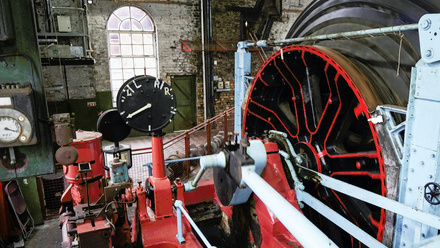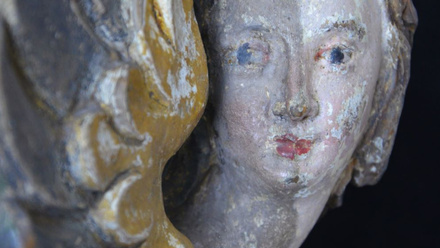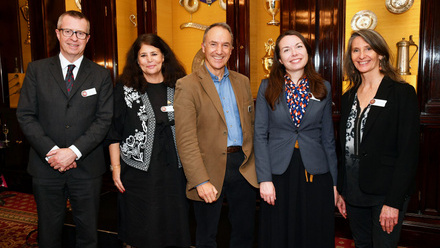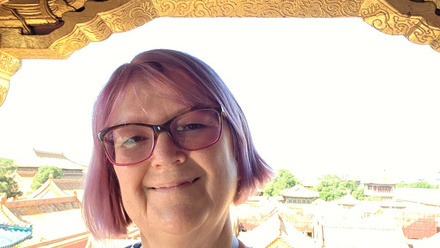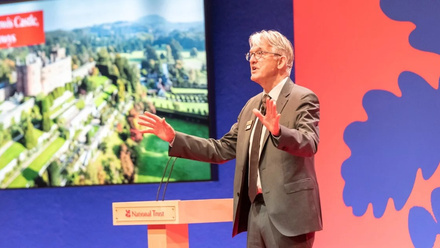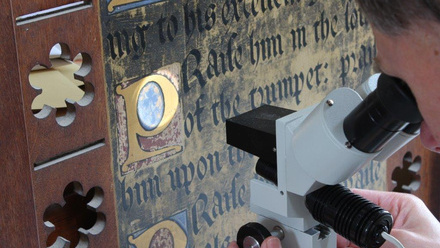Icon’s first Board of Trustees was elected on 6 December 2005. In celebration of the pivotal event, we asked our first Trustees to share their experiences of the time and what they've been up to since. From fascinating careers across institutions and private practice to cold water swimming and building a harpsichord - our Trustees have certainly kept busy. Read on to feel inspired by our very own trailblazers.
I still view Icon as one of, if not the most successful and impactful professional conservation membership organisations in the world.
Rose Briskman ACR
No great changes for me; I work in the conservation department at the Museum of London and am back to commuting by bike again, so my working life looks remarkably similar to how it did in 2005. I feel very lucky to work with this collection, and to be part of the team here, especially working with fellow paper conservator Clare Reynolds ACR who has converted me to cold water swimming and is always good for a giggle.
Simon Cane ACR
As Executive Director of UCL Culture I have oversight of four museums (including conservators), the Bloomsbury Theatre and Studio, a Public Engagement Team, a Collections Management Team, Public Art which includes commissioning new works from well known artists such as Rachael Whiteread as well as emerging artists and a Public Programmes Team.
I recollect the optimism of that first group of trustees, the majority of us had been actively advocating to unify the profession under the banner of Icon. It was long and challenging journey but with some excellent leadership and guidance and sheer determination we got there. I still view Icon as one of, if not the most successful and impactful professional conservation membership organisations in the world. We are a small profession but our organisation and representation are better than many larger, richer organisations. Icon is without doubt a success story and it is going to be up to the emerging and mid-career conservators to ensure that success continues!
Robert Gowing ACR
I served 3 years as an Icon Trustee as well as being on the Icon Conservation Awards Organising Committee. During that time I was the Head of Wall Painting Conservation at English Heritage (now Historic England). In late 2007, I took the decision to shift into the legal profession, and in 2012 qualified as a solicitor specialising in planning and environmental law.
I’m currently a Senior Associate at the City firm of Bryan Cave Leighton Paisner LLP, and advise on many heritage-related developments in London and the rest of England. I am an IIC Fellow, and continue to be a committee member for the Plowden Medal on behalf of the Royal Warrant Holders Association.
The creation of Icon was the coming of age of conservation in the UK.
Velson Horie ACR
I was then (like a few conservators of the time) project managing a major capital project: the £20m renewal of the Manchester Museum. A year later, I went to the British Library. I was asked to become Treasurer of IIC and resigned from the Icon Board, because of potential conflicts of interest. Eight years later, that job was done, so I am now concentrating on teaching (Chemistry for Conservators distance learning course and Materials for Conservation hands on - but not at the moment), while developing a web based visual catalogue of JMW Turner’s prints, for relaxation.
The creation of Icon was the coming of age of conservation in the UK. All those forming the new Board had spent years, sometimes decades, creating the climate to enable the separated strands to come together. Icon gave us renewed energy to use that change in structure to transform how the rest of the world viewed conservation, and how conservators thought of themselves. And it is working.
A quote from the Minister of Culture of the time David Lammy demonstrated its significance:
It has also historically been a world that's been fragmented into many different specialist bodies, guilds and associations, and it has not always been able to speak with a coherent voice. The reason I was so pleased with the launch of the Institute of Conservation was that it was the first major attempt to bring the bodies together so they can speak with a united voice. For example, it can make joint applications for funding.
Helen Lloyd ACR
When I stopped being a Trustee in 2011, I took on new responsibilities at the National Trust - a combination of my existing role as a National Specialist (Preventive Conservation Adviser - Housekeeping) and Consultancy Manager for the central team of National Specialist Curators and Conservation Advisers (12 specialists, 5 assistants and 2 business support coordinators).
Now, sadly, I am retiring on 14 December, after 38 years with the Trust, but leaving the team in the capable hands of Hannah Harte ACR, Head of Conservation - Collections & Interiors; Heather Caven, Head of Collections Management & Care; and Sally-Anne Huxtable, Head Curator. I hope they will enjoy working for the Trust as much as I have done, and continue its valuable relationship with Icon.
Emily O’Reilly ACR
Having recently returned from time working in Australia, I was encouraged to put myself forward for election by my wonderful colleagues at the time: Kate Lowry and Rachel Turnbull ACR. In 2005 I hadn’t even been accredited and it was an exciting time to be part of the new organisation.
Much has happened since then with family and work but the last three years have been an exciting time for me setting up myself as a freelance Paper Conservator. I am now very busy and enjoy meeting so many lovely clients and working on a variety of objects from private and public collections.
Heather Perry
I joined the board as the Welsh representative, while I was working for a museum service in the valleys just north of Cardiff. It was a very exciting time to be part of Icon, as it figured out what it was and how it could best serve the diverse conservation profession it represented, and I learnt a huge amount from my involvement.
I carried on working in Wales until 5 years ago, when I crossed the border over to England. I now manage Wiltshire Council’s Conservation and Museums Advisory Service, based at the Wiltshire and Swindon History Centre in Chippenham.
The team looks after the archives at WSHC, offers a range of conservation services to museums, archives, heritage organisations and the public, and provides support to Wiltshire’s wonderful museums. Every day is different! Part of my role is to work with South West Museum Development as Wiltshire’s Museum Development Officer, which means that (COVID restrictions notwithstanding) I’m lucky enough to travel around the beautiful countryside supporting colleagues to look after the county’s heritage.
Alison Richmond ACR
I remember very clearly how it came about that I became a Trustee on the first Board of Icon. I was at a UKIC conference in Liverpool and Carole Milner sat down beside me and said, “Alison, it’s about time that people like you stood up to be counted! You must stand for the Board.” Anyone who knows Carole will know that there is no saying no, so I did!
It was a great Board, led by the brilliant Anna Southall, who inspired us to reach a high level of board performance. We were also very lucky to have co-opted onto the board experts from outside the field of conservation, Lynne Thomas and Anne-Marie Newbigin, who were also able to act as critical friends. I was very fortunate to serve as one of the Vice Chairs to Anna along with Simon Cane ACR. Both Anna and Simon were wonderful mentors to me.
I was lucky, too, in being in the right place at the right time to take up the Chief Executive role at Icon a few years later. I have experienced boards from both perspectives and this continues to influence my approach to my current trustee roles at the Edward James Foundation (West Dean College) and The Restoration Trust.
one of the most enjoyable aspects of my career has been the opportunity to mentor and support conservation placement students, emerging conservation professionals and volunteers
Amanda Sutherland ACR
The work for the first Board of Icon Trustees was indeed a very busy time. I was working as a freelance conservator in 2005 and then later took up the post of Principal Conservator for the then Hampshire County Council Arts & Museums Service, leaving in 2015, shortly after the Service became an independent Trust.
Returning to freelance conservation and working out of a private studio, I then joined the National Trust as Project Conservator for ‘The Vyne Roof Project’, a hugely successful project comprising the re-roofing of a former Tudor palace, with associated service works upgrades. With 41 miles of scaffolding the site remained open to visitors and I was responsible for the care of the collections, historic interiors and the fabric of the building. The project ended in 2018 and I returned to freelance work, covering both remedial treatment and working as a preventive conservation consultant.
Most recently I worked for the Imperial War Museums at Duxford until the end of last year. Subsequently Coronavirus struck and this year has been tough for everyone. I would add that one of the most enjoyable aspects of my career has been the opportunity to mentor and support conservation placement students, emerging conservation professionals and volunteers across the heritage sector, particularly in promoting the valuable work of Icon.
Jim Tate
Ah, the heady days of the Icon Board changing the world! It seems such a long time ago, but it is good to see how far it has moved onwards and upwards since then.
I continued at NMS, which was when the museum started the grand project to renovate the Victorian building and transform the displays, leading to a continual stream of de-installation, conservation and re-installation challenges, achieved by the ever enthusiastic and wonderful conservation team. A range of analytical projects - an Egyptian mummy investigation and exhibition and contribution to the National Heritage Science Strategy and the Icon Heritage Science group. Later as a senior research fellow at Glasgow University the fading problem of early photographic prints.
Then I took (slightly) early retirement in 2012 – a move which I strongly recommend to anyone who has the chance – allowing my alternative life to flourish in the garden growing vegetables and building a harpsichord. We are fortunate to live in the country close to Edinburgh and so able to maintain contact with museum life, but this year sadly I will miss seeing my ex-colleagues as there can be no celebration of the 22nd anniversary of the Museum of Scotland today!
Chris Woods ACR
At that time I was acting as Treasurer for the board and so during the following months, having secured the elusive charity status in 2005 I was partly focused on ensuring that the funds from UKIC and other trusts in the ‘vanguard’ group could then be transferred to the new charity of Icon. As UKIC chair I had just successfully applied to HLF to get the development funds for a proposed internship scheme and during the year I worked on getting the eventual bid in, with Carol Brown ACR and David Leigh ACR, for a £1m grant (thankfully successful).
Juggling this at the time I was Head of Preservation for the Bodleian Libraries and soon after I was offered a Directorship at the Tate, primarily in order to bid to HLF again for a major new building. I also started a role as adviser for a number of Cathedrals for the care of their magna carta exemplar, touring one of them to the US. Sadly the Tate HLF bid was not successful so I left and took on a management role and research project for 18 months for University of the Arts (primarily Camberwell College as a Snr Research Fellow and for London College of Communications).
I ran a library and archive sector consultation about establishing a nationwide conservation consortium, to be based from Camberwell. UAL couldn’t fund it though so I set it up myself, as a non-profit membership organisation called the National Conservation Service, while running a consultancy and studio practice of my own. The membership organisation has steadily grown to 160 member institutions across the UK and wider British Isles, working on site in just over 100 of these, with a collaborative storage scheme as a more recent development (80 institutions storing with us currently). The practice is now three studios and 8 staff besides myself.
From 2009 I began the role of chair of the British Standards Institute’s committee for what was BS5454 (archive buildings) and is now BS4971, and then convened the UK-led replacement for 5454, EN16893 and have continued to be active with a variety of EN standards development.
Icon is grateful for the contribution of all past and present Trustees who have drawn on their wide and varied experiences to help set our strategic direction and priorities.
Feeling inspired by our Trustees' stories? A career in conservation is exciting and rewarding - find out more.

